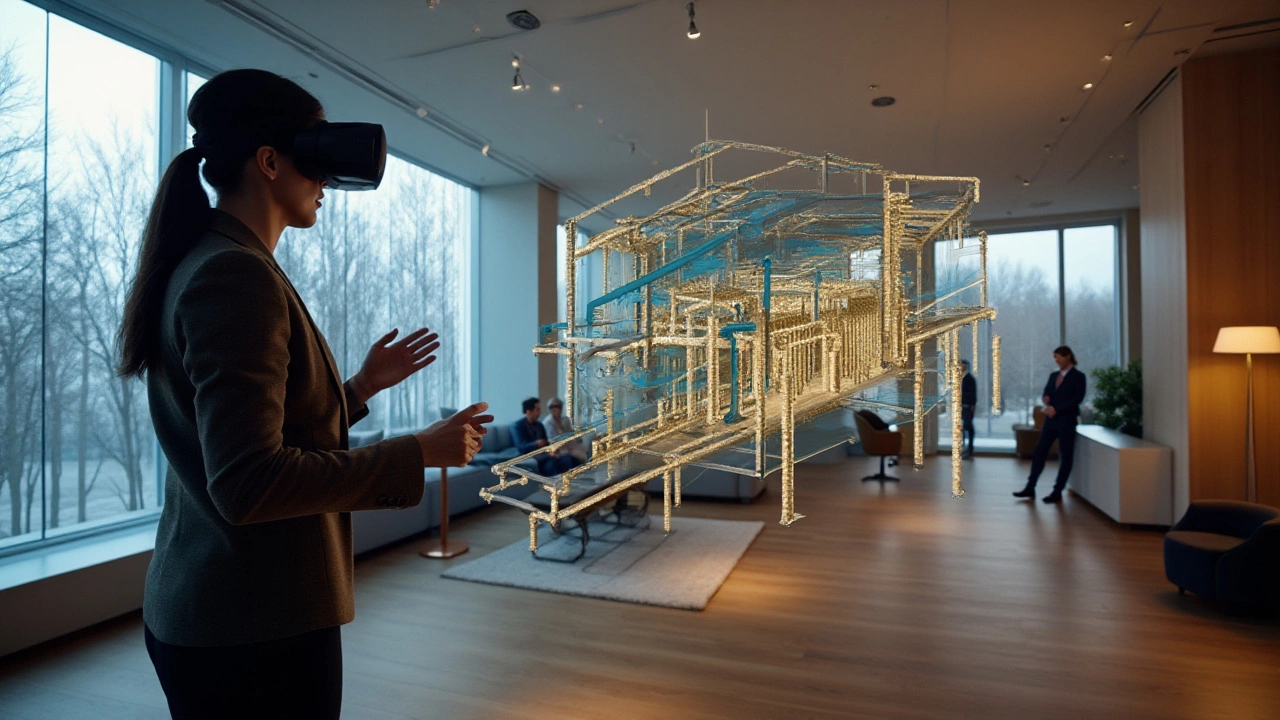In the dynamic field of architecture, a services architect holds a pivotal role, often operating behind the scenes to integrate vital systems within a building's design. While other architectural roles focus on aesthetics and structural elements, the services architect ensures that the mechanical, electrical, and plumbing components are seamlessly woven into the building's fabric.
The journey of transforming a blank canvas into a functional space often begins with the services architect's expertise. They are tasked with designing systems that are not only efficient but also sustainable and cost-effective. By working closely with other professionals in the field, they help bridge the gap between form and function, ensuring that buildings do not just stand, but thrive.
Their work is critical, demanding a blend of technical knowledge, problem-solving skills, and creativity. As buildings evolve with new technologies and environmental considerations, the role of the services architect continues to grow in complexity and importance, making it an exciting career path for those interested in the intersection of design and technology.
- Defining the Services Architect
- Key Responsibilities and Skills
- The Importance of Collaboration
- Challenges in the Role
- Future Trends in Services Architecture
Defining the Services Architect
In the bustling world of modern architecture, the role of a services architect emerges as both a linchpin and an innovator. At the core of their responsibilities is the integration of critical systems, without which any building would merely be a shell. Tasked with the intricate job of marrying building design with essential services such as HVAC, plumbing, and electrical systems, these architects ensure that the infrastructure not only functions seamlessly but does so with efficiency and sustainability in mind. The work of a services architect goes beyond mere installation, involving the conceptualization and planning stages to ensure all services align with regulatory standards and client expectations.
One might wonder where the inspiration for such a crucial role draws from. Historically, the concept of a services architect evolved from the necessity to integrate more sophisticated utility systems in buildings, influenced by industrial demands and technological advancements. The growth of high-rise buildings and complex commercial structures called for better coordination and management of internal systems. It's a bit more art than science when a services architect forecasts future needs and designs systems to be both adaptable and innovative. A building is a living thing, and services architects ensure it breathes life efficiently through its pipes, wires, and ducts.
A key part of defining this role lies in understanding the critical skills involved. A services architect must possess a deep knowledge of engineering principles, yet also carry strong creative instincts and problem-solving capabilities. They often operate within a collaborative framework, working alongside structural engineers, architects, and construction managers to bring a building to life. At the heart of their responsibilities is the understanding that every decision they make impacts the building’s efficiency, cost, and carbon footprint over its lifespan. With sustainable architecture gaining traction, their role becomes ever pivotal in achieving low-energy buildings and reducing environmental footprints.
The significance of a services architect comes from their ability to predict and solve highly specific engineering problems. Whether it is managing the delicate balance of airflow in a skyscraper or designing a water-efficient plumbing system for a multi-tenant building, their role is both challenging and rewarding. Among the many thrilling aspects of their job is the fast-paced evolution of technology. Today, services architects leverage cutting-edge software for simulations, efficient building information modeling (BIM), and smart systems integration, crafting spaces ready to meet the demands of tomorrow.
What's fascinating is how diverse their work environment can be. Services architects find themselves addressing different demands based on location and project type—from retrofitting historical buildings with modern efficiencies to developing systems for state-of-the-art healthcare facilities or cutting-edge data centers. In each project, they also stay on top of the latest industry trends and regulations, which are constantly evolving. The ever-growing emphasis on sustainable and green building techniques requires them to not just keep pace with current practices, but also innovate new solutions. A statement from the International Code Council highlights,
"Services architects are at the forefront of ensuring buildings meet the growing demands for energy efficiency and environmental responsibility without sacrificing performance or safety."
Key Responsibilities and Skills
The services architect has an expansive range of responsibilities, tackling the complex task of harmonizing technical systems with the architectural aspirations of a building. At the core, their primary duty is to conceive and design integrated systems that manage the infrastructure of a building, like heating, ventilation, air conditioning (HVAC), electricity, and plumbing. Each decision made must prioritize not only effective delivery and sustainability of these services but also their integration into the aesthetic and structural design. This often requires close collaboration with other design professionals, including architects and structural engineers, to ensure that no aspect of the building is overlooked or sacrificed.
A significant part of their role involves project management, which demands a proficiency in positioning resources efficiently and handling time constraints judiciously. This includes drafting budgets, negotiating cost-effective solutions, and ensuring that projects remain financially viable without compromising on quality or standards. Strong communication skills are essential here, as services architects need to liaise with both stakeholders and project teams, requiring a knack for problem-solving and negotiation.
Skills and Attributes
Exceptional problem-solving abilities are crucial in this role, as unexpected challenges can arise at any phase of development. Services architects must think on their feet, offering innovative solutions that align with client visions and regulatory standards. Creativity pairs with analytical skills to deliver results that are both inventive and grounded in practicality. According to a report by the American Institute of Architects, nearly 70% of modern buildings focus on energy efficiency, requiring architects to be adept with emerging technologies and eco-friendly practices.
"A services architect must balance the art of construction with the science of sustainability, keeping efficiency at the forefront," says Jordan Smith, a respected voice in architectural strategies.
The technical skill set involves a deep understanding of building information modeling (BIM) software, which is now an industry standard for visualizing building services within the holistic framework of a building's design. Proficiency in relevant engineering software is needed to simulate building dynamics and improve system performance. Additionally, knowledge of current building regulations and codes is indispensable, ensuring that all construction adheres to the strict safety and legal standards set forth by local and international boards.
These architects are also seen as pioneers in sustainability, weaving green technologies and systems into their designs to not only meet but exceed contemporary environmental standards. The drive for sustainability informs their every decision, highlighting the need for architects to be forward-thinking and proactive about the challenges of climate change. As buildings are among the largest contributors to global emissions, those in the field of services architecture are playing a pivotal role in designing the progressive cities of tomorrow.

The Importance of Collaboration
Collaboration is the lifeblood of architecture, and for a services architect, it becomes crucial in weaving together diverse components into a cohesive whole. Effective collaboration starts at the very beginning of the project lifecycle, where initial ideas are exchanged not just on aesthetics but also on intricate service systems like HVAC, plumbing, and building electrics. During these early phases, the synergy between the services architect, structural engineers, and other design team members lays the foundation for a successful project outcome.
As the project progresses, real-time communication and shared digital tools play vital roles. Services architects often use Building Information Modeling (BIM) to ensure that all stakeholders have a 3D visualization of the project, facilitating a shared understanding and reducing the risk of errors. This model allows everyone to see the implications of changes in one area upon the services architecture, enabling timely interventions and adjustments. This collaborative process not only enhances efficiency but also ensures that the final product is aligned with the client’s vision and operational requirements.
Moreover, working together encourages creativity and innovation. When a services architect collaborates freely with other disciplines, it fosters an environment where unique solutions emerge. For instance, a services architect might work with sustainable experts to integrate eco-friendly systems that serve both the building's needs and the planet. This interconnected approach often results in pioneering projects that push the boundaries of traditional architecture. As AIA architect James Ball said, "Multidisciplinary collaboration can transform challenges into opportunities for innovative solutions."
"Architecture is about how people live. The collaboration between different elements is what makes a building truly come alive, functioning harmoniously."
Given the advent technological advancements and global trends, the role of the services architect is becoming increasingly reliant on international collaboration. Projects might tap into global expertise, with engineers from different parts of the world contributing diverse perspectives. This creates a rich tapestry of insights, broadening the learning horizon for all involved while setting new international benchmarks for architectural projects.
Collaboration also fosters strong relationships and open lines of communication with contractors and builders. A fluid exchange of information ensures that the project's execution phase progresses smoothly. Misunderstandings are minimized, and the likelihood of rework is significantly reduced, saving time and resources. Today's architecture does not exist in silos; it thrives on shared visions and cohesive execution strategies. In a rapidly changing world, a services architect's capability to function effectively within a team determines the success of projects.
Yet, collaboration requires purposeful intent and effort. It demands the cultivation of soft skills such as listening, empathy, and negotiation, equally important alongside technical prowess. Acknowledging and valuing the contributions of others enhances morale and inspires teams to push boundaries. As the saying goes, "Alone we can do so little; together we can do so much." The role of a services architect thus becomes instrumental in guiding the collective effort, harmonizing every participant's strengths in pursuit of architectural excellence.
Challenges in the Role
Embracing the role of a services architect is not without its hurdles. One of the most pressing challenges involves balancing the technical requirements of a project with the overarching architectural vision. This balancing act requires an acute understanding of both engineering principles and architectural design, often needing innovative solutions to marry the two disciplines harmoniously. Services architects must continuously adapt to new technologies and materials that are constantly evolving, staying ahead of trends to ensure that their work contributes positively to sustainable building efforts.
Another significant challenge stems from the need to align all stakeholders' expectations and demands within a project. This involves effective communication and negotiation skills, as the services architect must liaise with clients, contractors, and other architects to ensure a smooth execution of plans. The complexity of integrating different service systems — such as HVAC, plumbing, and electrical — means that there is little room for error, demanding precision and attention to detail at every stage of a project.
Technical and Environmental Considerations
Technical constraints are a constant in the life of a services architect. Not only do they need to ensure that systems are efficient and functional, but they also need to comply with a variety of building codes and regulations that can vary significantly from one location to another. This legal landscape can be particularly daunting as even minor missteps can lead to severe delays and financial implications. Additionally, the push for environmentally-friendly and energy-efficient systems adds another layer of complexity, driving architects to explore sustainable practices while maintaining practicality and cost-effectiveness.
Moreover, the rise of smart building technology introduces yet another challenge, where services architects must integrate digital ecosystems into the fabric of their designs. This requires a new depth of knowledge in IT infrastructure and cybersecurity, making continuous education and adaptation an integral part of the job. A survey conducted by the Architecture and Engineering Journal reveals that over 65% of architects feel the pressure to upgrade their skills in these emerging technologies.
"The services architect is the unsung hero of modern construction projects, bringing together the practicality of engineering with the art of architecture," says renowned architect Frank Lloyd Wright.
- Understanding and implementing building codes.
- Balancing cutting-edge technology with traditional architectural principles.
- Managing client expectations and project timelines.
- Ensuring system efficiencies in unique project conditions.
Ultimately, while the role of a services architect is fraught with challenges, it also offers a rewarding opportunity to innovate and influence the future of architectural design. Architects who thrive in this field tend to be those who embrace change, excel in problem-solving, and have a passion for both technology and design.

Future Trends in Services Architecture
In an ever-evolving architectural landscape, the role of the services architect is continuously transforming, particularly in response to advancements in technology and increasing environmental concerns. Today, sustainability is no longer just a buzzword; it is a fundamental consideration shaping every facet of architectural design. Services architects are now increasingly incorporating renewable energy sources into their designs. Solar panels, wind turbines, and geothermal heating are becoming integral components in building systems, not merely as add-ons. This shift is largely driven by both regulatory pressures and client demand for sustainable solutions.
Technology is at the forefront of innovation in this field. The use of Building Information Modeling (BIM) is becoming widespread, providing architects with the tools to create more precise and efficient designs. BIM allows for detailed simulations of a building’s performance, from energy use to thermal comfort, enabling architects to make well-informed decisions early in the process. As a services architect, leveraging BIM not only improves efficiency but also enhances collaboration amongst all stakeholders involved, ensuring everyone is on the same page from the outset.
Moreover, the integration of Internet of Things (IoT) technology offers exciting prospects for the future. Smart buildings equipped with networked sensors provide real-time data on energy usage, air quality, and occupancy levels. This data can be invaluable, allowing services architects to optimize building systems for greater efficiency and reduced costs. Imagine a scenario where a building adjusts its own heating and cooling in response to the weather forecast or automatically turns off lights in unoccupied areas—this is not just futuristic thinking but the current trajectory for modern buildings.
According to a recent report by McKinsey, integrating IoT in buildings could lead to energy savings of up to 20%, making it an attractive proposition for developers and services architects alike.
The push towards smart cities further enhances the role of the services architect. As urban areas expand, there is a growing emphasis on creating interconnected urban environments where buildings communicate with each other and the broader city infrastructure. This means designing buildings that are not just stand-alone entities but active participants in an intelligent grid. The challenge lies in ensuring these systems are resilient and adaptable, considering the dynamic nature of urban ecosystems.
Looking ahead, the demand for adaptable spaces is likely to influence services architecture significantly. As the world adjusts to shifting work patterns, exemplified by the rise in remote working trends, the need for flexible building designs—spaces that can easily transform to suit various needs—becomes apparent. This adaptability challenges architects to rethink their approaches to building services. By ensuring systems are easily modifiable, services architects can future-proof their designs, allowing spaces to evolve seamlessly over time.
The future of services architecture is undoubtedly exciting, marked by significant opportunities and challenges. By staying abreast of technological advances and shifting societal needs, services architects are uniquely positioned to lead the way in redefining how buildings serve the people within them and the planet as a whole. As these trends continue to unfold, their role will become increasingly pivotal in shaping sustainable and intelligent built environments.
